► VW T-Roc R vs rivals
► The 300bhp crossover club
► Which one tops our ranking?
More versatile than a hot hatch, more powerful than your average compact SUV. So which 300bhp crossover is best?
Read on for our comparison test of the Volkswagen T-Roc R, BMW X2 M35i, Mini Countryman JCW and Range Rover Evoque.
Pre-flight briefing: VW T-Roc R
Why is it here?
The all-wheel-drive Golf R has been one of our favourite hot hatches since it launched in Mk6 guise a decade ago. Applying some of that R magic to Volkswagen’s new T-Roc could be a winning formula in the growing sporty compact SUV market.
Any clever stuff?
For the real performance nerds out there, there’s an optional quadruple Akrapovic titanium sports exhaust which weighs 7kg less than the standard T-Roc exhaust. It wasn’t fitted to our car so I can’t vouch for what VW describes as a ‘distinct, rich sound’, but I can tell you it costs an eye-watering £3000. Rich indeed.
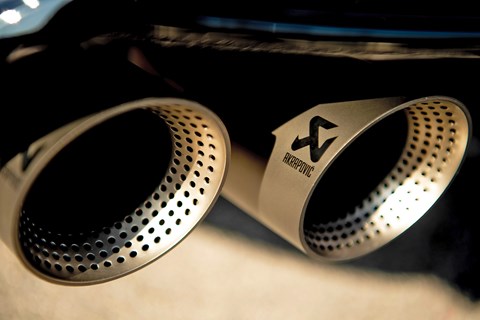
Which version is this?
T-Rocs come with five different petrol or diesel engines, manual or auto gearboxes and front- or all-wheel drive. The R means your get the 296bhp 2.0-litre turbo and all-wheel drive. Don’t confuse R with R-Line, by the way – that can be ordered as a 1.5-litre, manual front driver, which would be disappointing.
Check out our VW T-Roc R review
Pre-flight briefing: BMW X2 M35i
Why is it here?
The standard X2, even in 1.8 front-wheel-drive form, is a sweet-handling car, so the prospect of a hot M version with 302bhp and four-wheel drive is too serious a proposition to overlook… even if this coupe-hatch-SUV is actually a bit of a weird looker.
Any clever stuff?
This is the first four-cylinder M car since the original E30 M3 of 1986. The 2.0-litre unit appears in other BMWs, but the M35i gets a larger intake and turbo, reinforced crankshaft, lower-compression pistons and a redesigned cooling system. In this guise it produces 302bhp – 105bhp more than that first M3.
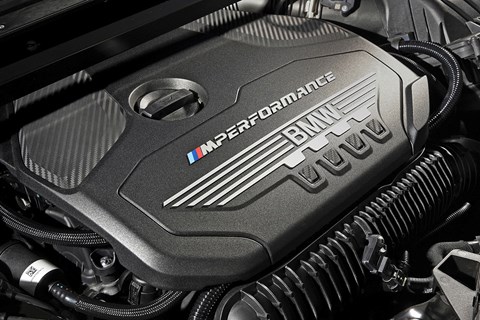
Which version is this?
There are two diesels and two less powerful petrols below the M35i in the X2 range. When ordering, make sure you do choose the M35i, not the M Sport model, which is an options pack that’s available on the 1.8-litre front-wheel-drive model, and instead of enjoying 302bhp you’ll get ‘high-gloss shadowline exterior trim and upgraded M light alloy wheels’.
Check out our BMW X2 M35i review
Pre-flight briefing: Mini Countryman JCW
Why is it here?
Minis haven’t always been big, but they have always had a reputation for giant-slaying speed. Fast-forward to 2020, and the combination of the Countryman’s 4×4 and the John Cooper Works treatment make this a real contender.
Any clever stuff?
Mini led the way in personalisation when BMW relaunched the brand back in 2001, and the option list is still long. One example (standard on the Cooper Works) is the ‘Mini Excitement Package’ which includes extra interior and exterior lights. There’s a Mini logo projected onto the ground when you unlock, there’s the LED ring around the centre binnacle, and ambient interior lighting with ‘255 colour nuances’.

Which version is this?
Lots of drivetrains for the Countryman, from a 1.5-litre three-cylinder front–wheel-drive car to the latest petrol and battery powered plug-in hybrid. Our John Cooper Works – upgraded last year with a new 302bhp four-cylinder turbo engine – is top of the range.
Pre-flight briefing: Range Rover Evoque
Why is it here?
When the Evoque was launched as a self-consciously fashionable SUV in 2011, it changed the fortunes of Range Rover, and showed how lucrative the compact SUV market could be. Almost a decade on the recently launched Mk2 is still a benchmark for premium 4×4 desirability.
Any clever stuff?
Loads of tech options: ClearSight Ground View uses cameras in the door mirrors and front grille to show a virtual view of what’s directly under your front bumper on the dashboard screen, making the bonnet appear to be transparent. The rear-view mirror also turns into a screen: the ClearSight rear-facing camera gives you a wide and uninterrupted view behind.
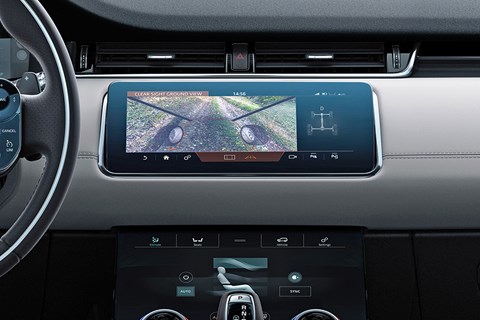
Which version is this?
Three diesel and three petrol engines are available, all 2.0 litres. Ours is the petrol P300 with 296bhp, in top-of-the-range R-Dynamic HSE trim, which includes 20-inch wheels, 380W Meridian audio and the Drive Pack with Adaptive Cruise Control, Blind Spot Assist etc.
Check out our Range Rover Evoque review
VW T-Roc R: the SUV that satisfies R urges
The car market over the last couple of decades has been, shall we say, ‘sector fluid’. With all the platform sharing and niche filling that’s been going on, the product range of every German manufacturer has become as bewildering as a giant chocolate selection box – one offering every conceivable flavour, fused and blended together. Like this car, the new Volkswagen T-Roc R: if it was a chocolate, it would be a strawberry crème bon-bon with a praline filling, coated with chilli chocolate and topped with a jellied banana. As a car, you might describe it as a ‘Junior 4×4 Suburban Crossover Sports Activity Coupe Hot Hatch’. Or, to put it another way, it’s the new Golf R SUV.
And this is seriously big news. The Golf R is one of our favourite cars: punchy 296bhp performance, all-wheel-drive security and brilliant handling. Plus compact SUVs are the hottest ticket in the car universe right now – from the Nissan Qashqai through to the Audi Q3, they’re every manufacturer’s bread and butter. So the R version of Volkswagen’s junior crossover should be the most zeitgeisty car on sale today, right? Perhaps. But we also want to know if it’s any good.

First, let’s briefly recap. The T-Roc was launched back in 2017, based on the same MBQ platform as its Golf sibling. It’s slightly shorter and wider than Volkswagen’s ubiquitous family hatch, but importantly it’s also 81mm taller, with a more upright driving position to give drivers that much-sought-after jacked-up view over the bonnet. Even if we’re only talking about a few millimetres here, the sales charts tell us it’s what customers want.
And now – just as the Mk7.5 Golf is replaced and the current Golf R dies along with it – the T-Roc gets the R treatment. That means the same 2.0-litre turbocharged petrol engine, the same seven-speed dual-clutch gearbox and yes, the same 4Motion all-wheel-drive system as the outgoing Golf R. The top-of-the-range T now puts out a frisky 296bhp and 295lb ft of torque; to signify that intent, it also gets mildly redesigned front and rear bumpers, new side sills, wheelarch extensions and a little roof spoiler. Plus there are 19-inch wheels as standard, and ‘R’ sports suspension – which, rather ridiculously, lowers the car back down to round about Golf height, thus losing that much-sought-after jacked-up view over the bonnet I was talking about earlier. Yeah, I know – compact SUV crossovers make no sense.
Even crazier is the price: while the Golf R was just over £36k, the new T-Roc R is £38,450. This example, with a few extras (like the Dynamic Chassis Control adjustable dampers, £695, and the black roof, £425) comes in at a sharp-intake-of-breath £41,919. It seems the manufacturers’ bread and butter also comes with a dollop of jam in the middle.
Inside, the T-Roc R gets sculpted front seats with racy cloth upholstery and R logos stitched into the backrests. The sports steering wheel is lovely – covered in fine, smooth leather, it’s one of those wheels your hands clasp and you immediately think ‘Oooh yes’. The dashboard is neat and orderly if rather utilitarian in appearance, and the materials feel strangely low-rent for such an expensive car. This might sound more than a little strange – modern Volkswagens are renowned for their solid, rubbery plastics and beautiful build quality after all. But there’s something about the body-coloured plastic strip that encircles the T-Roc’s cabin that misses the mark.
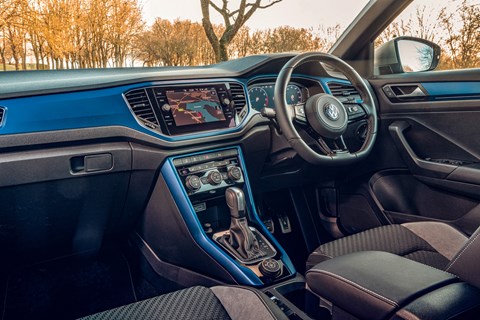
But let’s set all that aside because it’s time to drive, and the Golf R has set our expectations so high. The T-Roc R doesn’t disappoint. Push the start button, stir the (rather long) gear-wand into D, and we’re off. Straight away, this new high-rise R feels every bit as well resolved as the Golf that came before it, the taut but compliant suspension riding well over our winding B-roads. There’s a little rotary dial that allows you to configure the 4Motion system to snow or mountains and so on, and in the Road setting you can then press a button to choose between Eco, Comfort, Normal and Race. Of course, I immediately choose Race and discover, like its Golf sibling, that the T-Roc R is a very quick car cross-country. The 2.0-litre turbo revs rapidly and willingly up to the 6500rpm redline, with an angry, hard-edged fizz, and the gutsy midrange is always ready to give you a satisfying catapult out of the slower bends. Like the Golf, the steering is accurate if a little lacking in feel, but it’s not the initial direction change that impresses most. It’s more about the way the rest of the T-Roc follows that steering input – there’s practically zero bodyroll, none of the movement you might expect from an SUV. You never feel like the front wheels are leading and the rear bumper is following along a couple of seconds later. Instead, the T-Roc moves as a piece, with a cat-like composure and deftness.
The only control that takes a bit of getting used to is the brake pedal: all the action is at the very top, the first couple of millimetres of travel, which makes the brakes a bit grabby.
But overall (as you’d expect) the T-Roc R carries over much of the Golf R’s feeling of confidence, speed and self-control. It shares that ability to demolish a bumpy back road while at the same time offering everyday comfort and usability too. So, we have a winner?
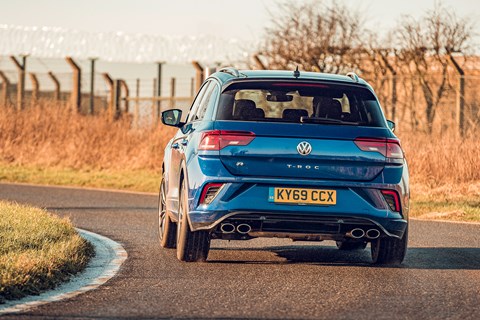
Not quite. Because the whole time I’m driving the T-Roc R, I just keep asking myself ‘why?’ – why choose this instead of a Golf R? For starters, I don’t think the design is as neat or as polished as the Golf’s. The nose is strangely characterless; there’s that strange flared swoop in the bodywork just above the rear arches; and the very short rear overhang looks out of proportion with the rest of the design. That chopped rear also inevitably affects the T-Roc’s practicality as a family SUV. Because it’s wider and taller than the Golf, the T-Roc’s boot does offer 392 litres of luggage space, rear seats up, compared with the Golf R’s 340 litres. But it’s hardly cavernous for an SUV, and that sloping rear hatch reduces the boot down to a narrow-topped wedge shape, an awkward niche that looks like it would struggle to swallow a pram or a pushchair.
And then there’s the cost – driving along, I find it difficult to justify that extra couple of grand, when I’m just wondering what the T-Roc adds to the sublime Golf R. I guess if you jump straight out of one and into the other in the showroom, you may simply prefer the T-Roc’s driving position. Otherwise, why, why, why?
So the T-Roc R is good to drive but far from perfect – and it’s definitely not the hands-down winner yet.
BMW X2 M35i: small SUV, great expectations
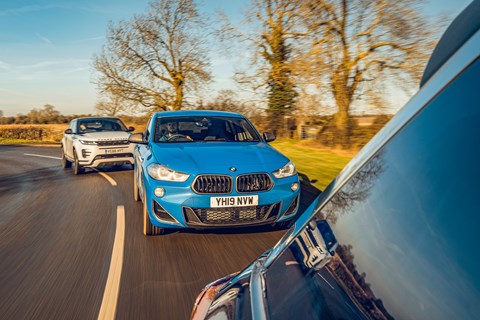
Now, if there’s one car that truly represents the complex, chaotic, blended car landscape of 2020, it has to be this one. I mean, what is the BMW X2? A high hatch? An low SUV? A boxy coupe? A sleek 4×4? An abomination? Maybe all of the above. I’m not a fan.
Like the other cars here, the new X2 M35i arrived within the last 12 months, capitalising on the growing market for (you know it) 4×4 Suburban Crossover Sports Activity Coupe Hot Hatches. This new M-badged car comes with the same engine and gearbox as our Mini Countryman JCW, BMW’s B48 twin-turbo 2.0-litre, putting out 302bhp. The difference is in the drivetrain set-up: the BMW xDrive all-wheel-drive system is rear-biased, whereas the Mini’s ALL4 leans very much on the front.
As well as the upgraded 2.0-litre turbo engine versus a regular X2, the M35i also gets stiffened, lowered M Sport suspension and a mechanical limited-slip differential for the front wheels. If you’re wondering where the exterior styling differences are, you need to peer very closely at the air ducts in the front bumper and the tailpipes. No, there isn’t a lot of meat to feed BMW fanatics here; and yes, if you think the holy M division badge should mean iconic M3s and M5s, I agree, this frumpy, bloated little hatch is baffling – though it is one step down from a ‘full’ M car, which would be an X2 M.
Rest assured, though, this car gets a proper M price: the X2 M35i starts at £42,000 and our example, with a few extras (like the Tech Pack, including head-up display, £1260; and the Plus Pack, including an upgraded Harman Kardon sound system, £995) comes in at £46,945. At which point I look again at this car and think, ‘Eh?’
Still, thankfully it lives up to the M legend when you’re on the move. Inside, you get a really fat handful of leather-bound steering wheel and heavily bolstered sports seats. The driving position is excellent, the steering wheel extending right out towards you for that bent-elbow DTM driving position. The seats are electric, by the way – the Mini and T-Roc have manual sliders.
The dash is strangely old fashioned considering this is a brand new car, with a colour screen that looks like it was plonked on top as an afterthought, and some very analogue-looking main dials inside the instrument binnacle. The Evoque’s streamlined, high-tech interior sets the bar in this test.
But on the move the X2 easily eclipses the more comfort-focused Range Rover, just as the VW and Mini do. It’s another surprisingly rapid car – 0-62mph in just five seconds, the four-cylinder turbo revving freely to the 7000rpm redline. It has a different aural character to the Mini and the T-Roc: harder edged than the Volkswagen, but without the gutsy bark that defines the Mini. It actually sounds quite BMW-ish. If you choose the Sport mode, it adds a bassy underscore to the engine noise, but this sounds fake (because it is). Like the other cars, I experimented with the BMW’s Comfort/Sport settings, but they don’t make a huge difference.
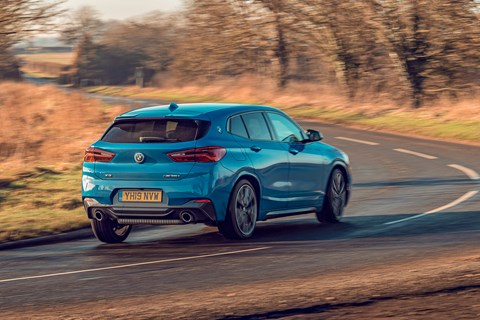
What the X2 does really well is control the pitch and roll of that tall body. At lower speeds the firmer suspension feels very busy, bobbling your head around on your shoulders; but at higher speeds everything smooths out, the car glossing over bumps like a speedboat skimming over choppy water. The steering is quite loaded, though (like all of these crossovers) it’s also a little bit sterile, the weightiness failing to translate into feel. Nevertheless, the car turns in really sharply and drives hard out of every apex. It may not be as exhilarating as the Mini, but the M35i matches the T-Roc in carrying some startling speed down a British B-road.
It made me think of that legendary test that every car journalist talks about, comparing a hot hatch to a Lamborghini Aventador over a tortuously twisty road, to prove that a small, confident car is always quicker than a big, scary one. The compact X2 would be a good candidate: it feels comfortable at a high, frenetic pace, and its size means you can thread it through corners with a lot of trust.
Whether it would be comfortable on the school run is another matter. The jiggly ride would get tiring around town – but I guess if that’s your concern, you’d choose a standard, front-drive X2 and save the money.
So the X2 M35i is another example of a tall SUV being tuned brilliantly to drive like a proper hot hatch. You could say the best of both worlds; but which is the best out of these four?
Mini Countryman JCW: Mini to the max

Is it just me, or is it weird that the biggest Mini is now almost the same size as the smallest Range Rover? The Countryman is just 7cm shorter and 9cm lower, and park the two side-by-side and they have a very similar physical presence. Alec Issigonis, the Mini’s designer, would be horrified; but let’s face it, who wants to drive an original Mini nowadays? It would be like driving a pedalo among oil tankers.
Like the Evoque, the JCW Countryman also received an update last year, making it not only the biggest but also the most powerful road-going Mini ever. The 2.0-litre twin-turbo engine was upgraded to produce 302bhp and 332lb ft, driving all four wheels through a new eight-speed auto ‘box. Well, I say ‘all four wheels’ – in fact, Mini’s system is similar to the T Roc’s 4Motion drivetrain in spirit, in that it’s essentially a front-wheel-drive car until it detects wheel slip, then it diverts torque to the rear. In terms of hardware, it’s the BMW and Mini that are twinned.
Prices for the John Cooper Countryman start at £35,550, but our car is optioned with British Racing Green paint (£595); red stripes (£200); 19-inch wheels (£700); a navigation pack (£1300); plus other bits and pieces that bring it up to T-Roc R levels, at £39,525.
What to say of the Countryman’s exterior design? You get the sense that the styling team was tortured into giving it a familiar Mini face, with that blunt nose and upright windscreen. Next to the Evoque and T-Roc, it looks like a pug.
That upright stance continues inside, where you find a high ceiling, supportive but very upright seats and a vertical wall of dash smothered in circles. Like the exterior, I feel the circle thing is a little try-hard – ‘It’s a Mini, so we must have a giant circular binnacle in the middle of the dashboard!’ This ‘Mini Theme Park’ design approach creates some jarring details, like when you need to fit a rectangular sat-nav screen into a circular hole. I find it too much. Some bits are cool, like the toggle-switch starter button; other details less so, including the thin halo around that centre binnacle, that changes colour, blue to red, to reflect the heating system. At times it looks like you’ve got a Wurlitzer jukebox in the middle of the car.
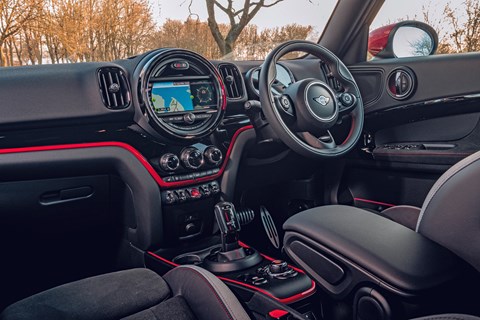
But any accusation that this is now a superficial brand soon falls aside when you get going, because the Mini engineers have done an amazing job of somehow injecting Mini-ness to the way this thing drives. I know, it’s bizarre.
First of all, it’s quick, and like the T-Roc the speed is right there, ready to be exploited as soon as you set off. You have to get used to the slight torque-steer effect of that 332lb ft going through the front axle – a sudden squeeze of the throttle will make the steering momentarily writhe in your hands. Mini claims this Cooper Works Countryman will do 0-62mph in 5.1 seconds, but I’d say it actually feels faster than the T-Roc (4.8sec), rather than a fraction slower. That’s partly down to the noise it makes – a noticeably raspy, rorty growl that’s much more exciting than the T-Roc – but it’s also the way it handles itself in tighter corners. It feels heavier than the T-Roc (it is, by a few kilos) and it also feels very front-wheel-drive, as though the whole focus of the car is about those front wheels. Like a Mini, you might say, despite its bulk, despite its all-wheel drive and despite Issigonis spinning in his grave. That focus on the front axle also gives it a sure-footedness that inspires a lot of confidence; in no time, you find yourself absolutely chucking the Mini into bends.
Like the other cars here, the Mini has different driving modes to choose between, and like the others the modes don’t appear to make a great deal of difference, beyond a bit of throttle mapping. In any setting, the Mini just feels more alive, more game for a laugh than the efficient T-Roc R.
The Countryman doesn’t demolish corners with a dismissive flick like the Volkswagen – there’s a lot more going on in the Mini, in any given corner. But that involvement – the feeling that you’re really driving it – makes it more fun. And if fun is what we’re looking for, then maybe the Mini should be the winner. Not yet, because we have one more car to drive.
Range Rover Evoque: still posh, now with less spice
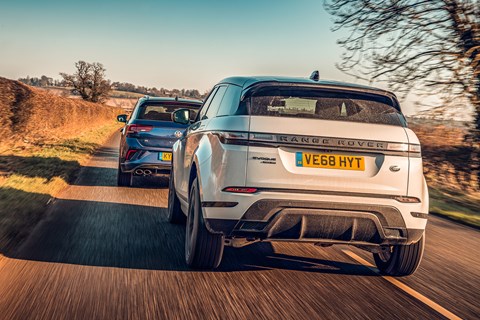
Is the Evoque actually a competitor to the T-Roc R? Going by price alone, Volkswagen would probably argue not – a basic P300 HSE R-Dynamic like you see here is £51,050, 10 grand more expensive than the Volkswagen, and that’s before you tuck in to the extensive options list. This example has the Yulong White metallic paint (£640 extra), the black contrast roof (£535), Adaptive Dynamics suspension (£800), and most expensive of all, a non-opening panoramic roof (£1100). Altogether, we’re testing a £55k car here, which is really quite chunky for a ‘premium compact SUV’.
But look at it another way: if you’re in the market for a compact, premium, ‘lifestyle’ SUV, are you saying the Evoque wouldn’t be on your list? Of course it would – since it was launched in 2011, the baby Range Rover has been the archetype of the posh, urban, compact 4×4 and they’ve shifted hundreds of thousands of the things.
Then last year the Evoque underwent a major ground-up revision, improving everything from ride quality to rear legroom without radically altering the tried and tested design. Not that you can’t tell old and new apart: the facelift honed what was always a handsome car (love it or loathe it), and it brought a new minimalism to the details, with Velar-inspired lights and those fancy retractable door handles. Everything is flush and exact, like the kitchen units of a particularly obsessive architect. That simplification allows your eye to appreciate the overall shape, with those muscular arches and swept-up glasshouse.
Like the T-Roc R, the Evoque’s 2.0-litre turbo petrol engine puts out 296bhp and 295lb ft. Unlike the Volkswagen, the Range Rover has full-time four-wheel drive through a nine-speed automatic gearbox. The Evoque is bigger and 350kg heavier than the VW, so you get fewer fireworks from that 296bhp: 0-62mph takes 6.6 seconds, compared with the VW’s 4.8 seconds.
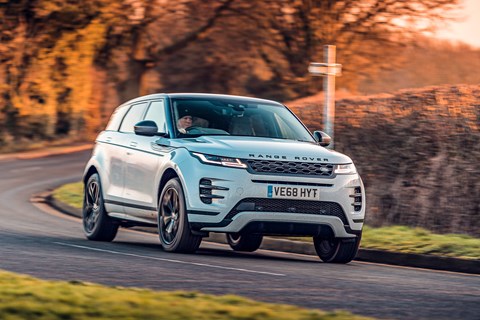
But the Evoque is still useful in this test, because it’s the benchmark for premium, compact SUV interiors. I love this cabin: the seats are finished in an unusual half-and-half fabric trim (a no-cost option): the upper part is Range Rover’s Kvadrat cloth in Dapple Grey, which contrasts with the ebony Dinamica suedecloth below. It’s unusual, contemporary and cool.
Overall the cabin has a laid-back lounge feel – your seat is naturally more reclined than in the T-Roc, the dashboard slopes towards you, and ahead the windscreen is raked like a sports car’s. It feels much more like a coupe than the T-Roc.
At the centre of the Evoque’s dash lie two glossy 10-inch touchscreens, giving the occupants more of an iPhone/Samsung experience than the more analogue Volkswagen. In comparison to the Range Rover’s slick modernity, the new T-Roc R feels a generation out of date already (and arguably it is, seeing as it borrows hardware from the outgoing Golf).
So altogether the Evoque interior is way ahead of the T-Roc’s, and it’s a massive part of the Range Rover’s appeal. Let’s face it, when you’re not thrashing down that dreamy B-road, in reality you’re schlepping up the motorway; and when you’re not exploring Iceland’s interior, your four-wheel-drive SUV is actually going to be stuck in traffic. So in the real world, I’d rather be in the Evoque than a T-Roc R.
So the Range Rover wins? Not yet. Because just when you’ve fallen in love with the clicky rotary dials or the elegant door-pulls (mmm…), you then have to drive it.
Now, in principle there’s nothing wrong with the way the Evoque goes: it rides well, the engine is hushed unless really extended and the nine-speed gearbox keeps a low profile. But pile on speed and the Range Rover’s limitations quickly start to show – it feels an intentionally more comfort-focused car than its predecessor. Even if you put it in Dynamic mode (ludicrously represented on the screen by a racing helmet, ha ha), the Evoque’s movements become more wallowy, like a water bed compared with the tight jiggling of a freshly-made jelly, straight out the fridge. (The T-Roc R is the jelly in that metaphor, in case that wasn’t clear.)
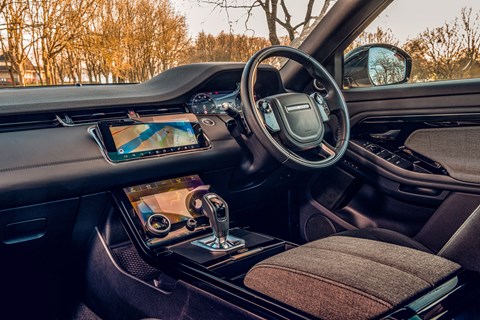
It’s not that the Evoque can’t press on – it has 295bhp and all-wheel drive after all. But trust me, you just won’t want to. The steering wheel is a twirl-with-one-finger affair, offering zero road feel, and when you turn in there’s a noticeable amount of bodyroll. Whip the Evoque through two or three corners in quick succession and you’ll soon realise it’s no fun driving it like that, and you’ll slow down.
So the baby Range Rover is very good at what it does; but what it does is not the same as what the T-Roc R does.
The final reckoning
If we’re benchmarking these cars against the new Volkswagen T-Roc R (and we are), then the first to be discarded is the Range Rover. But I’m really impressed by this car, and if you told me I had to drive to John O’Groats, right now, just jump in and go, I’d choose the Evoque immediately. Smooth, refined, and with a premium interior that’s so inviting. When you travel by plane, do you want to wait in the first-class lounge or fall asleep on a plastic bench by the departure gate? Exactly.
If the Volkswagen’s ‘R’ badge means we’re judging these cars by their sportiness, the Range Rover fails. But as an alternative take? I like it.
At the opposite end of the scale is the Mini Countryman John Cooper Works. It’s a proper, raucous hot hatch, wrapped up in the more bulbous body of a faux off-roader. It’s fantastic fun to drive and very quick. There’s something pleasingly ‘old school’ about the John Cooper Works – it clearly values driver engagement. It’s a car you could enjoy flinging through every roundabout on your daily commute.
Between these two bookends lie the new T-Roc R and BMW X2. It’s weird. They have so much going for them dynamically, and of course they’re both practical and well made. But there’s something about them both that leaves me cold. It’s the styling: neither is handsome enough; their proportions are awkward on the eye.
And while they do possess a wicked turn of speed, they somehow lack a vital spark of enjoyment. If I had to choose between them, it would be the T-Roc R, because the drivetrain and ride of the new Volkswagen carries over some of the magic of the Golf R. But that hardly represents a clear victory over the BMW, because I’d spend my whole time in the T-Roc wondering why I didn’t just buy the Golf.
So in reality I wouldn’t choose either of them – I’d choose either the Mini or the Range Rover, depending on how many motorway miles I needed to do. Both are more easily understood, with more clearly defined personalities. I don’t ‘get’ the T-Roc or the X2, but the appeal of the Mini and the Evoque is instinctive.
And if we’re judging this cars on sportiness? Then of course the John Cooper Works has to win.

T-Roc R vs X2 M35i vs Countryman JCW vs Evoque P300: verdict
First place: Mini Countryman JCW
More practical (and uglier) than a regular Mini, but still infused with John Cooper magic.
Second place: Range Rover Evoque P300
Cabin as big on tech as relaxation, and a likeably soothing drive. Isn’t sporty. Is pricey.
Third place: VW T-Roc R
Predictably if impressively a high-rise Golf R in concept as well as execution. But… just buy a Golf R.
Fourth place: BMW X2 M35i
Unappealing design, off-the-pace cabin, on-the-pace drive, X2 is your tombola on wheels.
Check out more CAR comparison tests here